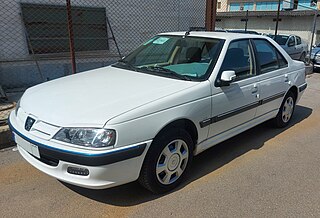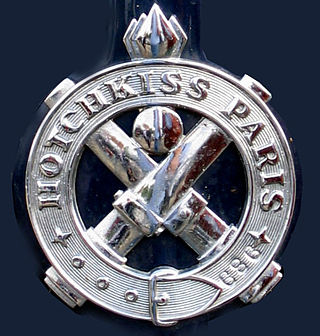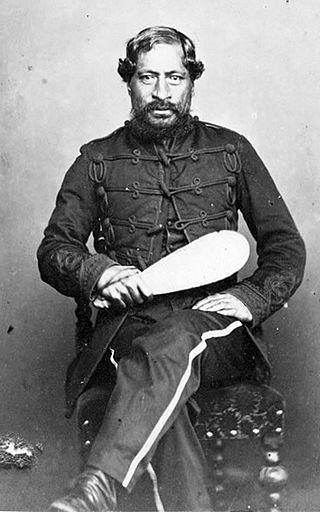Related Research Articles

Peugeot is a French automobile brand owned by Stellantis.

The Peugeot 205 is a supermini (B-segment) car produced by the French manufacturer Peugeot from 1983 to 1999.

The Peugeot 405 is a large family car manufactured by the French automaker Peugeot from 1987 to 1997. Its production continued under license from outside Europe in Iran by Iran Khodro Company until 2020. It was voted European Car of the Year for 1988 by the largest number of votes in the history of the contest. About 2.5 million vehicles have been sold worldwide, both in left and right drive versions, as a saloon and estate. In early 2020, the 33-year production run of the Peugeot 405 was counted as the twentieth most long-lived single generation car in history."

The Peugeot 504 is a mid-size, front-engine, rear-wheel-drive automobile manufactured and marketed by Peugeot from 1968 to 1983 over a single generation, primarily in four-door sedan and wagon configurations – but also as twin two-door coupé and cabriolet configurations as well as pickup truck variants.

Iran Khodro, branded as IKCO, is an Iranian automaker headquartered in Tehran. IKCO was founded in 1962 as Iran National. The public company manufactures vehicles, including Samand, Peugeot and Renault cars, and trucks, minibuses and buses. As of 2009, it produced 688,000 passenger cars per year.

The Peugeot 104 is a supermini car produced by the French company Peugeot between 1972 and 1988. It was designed by Paolo Martin was initially only sold as a four-door saloon car, with a three-door hatchback variant introduced in 1974 and a five-door hatchback version replacing the saloon in 1976. The 104 was the first model produced at the company's Mulhouse plant. It was also the first new Peugeot introduced since 1955 not to be offered in a diesel version.

The Peugeot 403 is a mid-size car manufactured and marketed by Peugeot between May 1955 and October 1966. A total of 1,214,121 of all types, including commercial models, were produced, making it the first Peugeot to exceed one million in sales.

The Peugeot 305 is a medium-sized car produced by the French automaker Peugeot from 1977 to 1989. It was offered as a four-door saloon, five-door estate, and as a three-door van derivative.

The Fiat Fiorino is a small commercial vehicle produced by the Italian car manufacturer Fiat since 1977. Its first two generations have been the panel van derivatives of other small models, such as the Fiat 127 and Fiat Uno, while the current third generation was developed jointly with PSA Peugeot Citroën, and is based on the Fiat Small platform.

The Peugeot Pars, also known as Peugeot Persia, is a passenger car produced by the Iranian carmaker Iran Khodro. After 10 years of manufacturing the Peugeot 405 in Iran, the company designed the Peugeot Persia as its facelift, with a front end similar to that of the Peugeot 406. The Peugeot Persia was soon renamed Peugeot Safir and eventually Peugeot Pars because of local copyright problems. The Peugeot Pars has been made in multiple variants. The 16V, ELX and LX models use more powerful PSA 16-valve engines and a few other improvements.

Automobiles Hotchkiss manufactured luxury cars in Saint-Denis, Paris between 1903 and 1955 and trucks between 1936 and 1970. It was a subsidiary of the French company Hotchkiss et Cie. The badge for the marque showed a pair of crossed cannons, evoking the company's history as an arms manufacturer. Hotchkiss also briefly built cars under the Hotchkiss Grégoire brand after the war. Hotchkiss went through a number of mergers and takeovers after the war and the brand disappeared in the 1970s; its successor companies went on to eventually form the partially state-owned Thales Group.

A patu is a club or pounder used by the Māori. The word patu in the Māori language means to strike, hit, beat, kill or subdue.

The Peugeot 201 is a car produced by Peugeot between 1929 and 1937.

Māori traditional textiles are the indigenous textiles of the Māori people of New Zealand. The organisation Te Roopu Raranga Whatu o Aotearoa, the national Māori weavers' collective, aims to preserve and foster the skills of making and using these materials.

The Peugeot Type 153 was a new model from Peugeot for 1913, made in various forms until 1925.
The Peugeot Type 66 was the first large car from French automaker Peugeot, as well as the first vehicle from that manufacturer to have four cylinders. Most were made as closed-top limousines. The engine displaced 5.0 L and produced 25 horsepower (19 kW), which was sufficient to carry the car to a top speed of 87 kilometres per hour (54 mph). Production ran throughout 1904 and a total of 20 were built.

The Peugeot 2008 is a subcompact crossover SUV (B-segment) produced by the French automaker Peugeot. Unveiled at the 2013 Geneva Motor Show and positioned below the 3008, the first 2008 replaced the Peugeot 207 SW, as Peugeot did not release an SW version of its 208.

The Renault Celtaquatre is a small family car produced by the French manufacturer Renault between 1934 and 1938. Although French, it took some of its styling cues from American cars of the time. Its rounded silhouette gave it the nickname “Celtaboule” ("Celtaball").

The Peugeot Type 177 B was a mid-range car produced between 1924 and 1929 by the French auto-maker Peugeot. With a fiscal horsepower of 10 CV, and a wheel base of 2670 mm, it competed in the same sector as the Citroën B2 and Renault KZ.

The Peugeot Type 2 is the first petrol/gasoline-powered motor vehicle produced between 1890 and 1891 by the French auto-maker Peugeot at their Valentigney plant. The car was presented just two years after Armand Peugeot had split away from the Peugeot family business in order to concentrate on cars, with a separate Peugeot Automobiles business.
References
- Production figures
- Company history page on Type 54
- Te Papa Museum